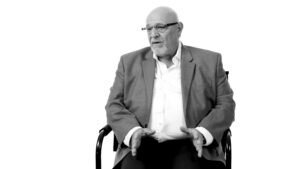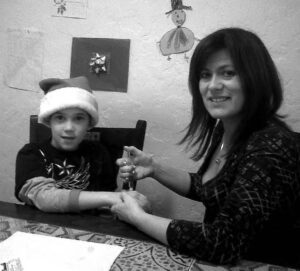Rare Community Profiles

Rare Community Profiles is a new Patient Worthy article series of long-form interviews featuring various stakeholders in the rare disease community, such as patients, their families, advocates, scientists, and more.
From the 1960s to Now: How Two Hemophilia Advocates Have Seen Treatment and Research Progress
In the 1960s, the treatment landscape for hemophilia was bare. Not only did the medical profession know little about this rare bleeding disorder, but there were no therapies designed to help.
In the 1960s, the life expectancy for people living with severe hemophilia was just 11 years old. When Wayne, now 62 years old, was diagnosed, his family was told that he wouldn’t live past age 20.
Revolutionary advances in the realm of hemophilia treatment, such as the development of clotting factor concentrates, have significantly changed the outlook. With proper treatment, most people with hemophilia live long, full, and fulfilled lives.
To Wayne and Nathan, a college student with severe hemophilia B, these advances have changed their lives. Now, both men are remarkable advocates for the hemophilia community and share their story to remind others that they are not alone.
Wayne’s Story
When Wayne was five years old, he was out playing with friends. Distracted by sunshine and “make-believe,” Wayne fell and hit his head. It wasn’t necessarily a super hard hit. But the complications that developed were frightening. Wayne required surgery to fix a subdural hematoma, where blood pools between the brain’s covering and the skull surface. Luckily, the surgery went well. Wayne seemed to recover without any issues.
Yet doctors noticed another problem during a surgery to remove his tonsils and adenoids. They struggled to control the bleeding during the procedure. Wayne’s family was told that he and some familial cousins should be tested for bleeding disorders. The tests came back positive. All three boys had hemophilia; Wayne was diagnosed as having severe hemophilia B.
At the time, little was known about hemophilia. Wayne shares:
“My parents had no education on hemophilia. We lived in a very rural area in upstate New York and doctors didn’t know much about this disorder. All we were told is that I wouldn’t live for very long and, if I got hurt, I had to get plasma at the hospital.”
Whenever he was injured, Wayne would spend days or weeks in the hospital getting treatment. It wasn’t until he was around 25 years old that his approach to care changed. He had moved to a new, larger town with more medical resources. After he experienced complications from wisdom tooth removal, a nurse at the hospital pointed him in the direction of a hemophilia treatment center. Wayne visited, intent on furthering his understanding and finding out how to better manage his condition. He explains:
“Meeting with the doctors and nurses opened my eyes. What really affected me were the ramifications of how severe my hemophilia was. I didn’t realize how bad it was and how lucky I was to still be around.”
Understanding Treatment Options
Prior to this point, treatment options for hemophilia largely centered around fresh frozen plasma and blood transfusions. The advent of factor concentrates opened up novel therapeutic options that seemed to overcome some of the prior barriers to treatment. But in the 1980s, HIV from infected blood donors made its way into the blood supply. According to the Colorado Chapter of the National Hemophilia Foundation, an estimated 90% of people with severe hemophilia, and 50% of all people with hemophilia, contracted HIV during this time. Wayne shares:
“We lost a lot of people in the community during the HIV/AIDS crisis in the 80s. I was very fortunate that I didn’t contract HIV, but I did contract hepatitis C. I lost a lot of friends to HIV. But I’ve seen good emerge from the bad. Companies took notice and worked to ensure that their products wouldn’t cause any issues. We have the safest blood supply in the United States and that’s because of the hemophilia community.”
Although Wayne’s hemophilia still caused joint damage, requiring knee replacements in his late 20s (and again in his 40s), as well as some other health issues, factor IX infusions have been immensely helpful for him. He currently infuses prophylactically.

The other huge milestones in research and development within this field, from subcutaneous injections to gene therapy, have made a wide-reaching impact. Says Wayne:
“I never would have thought, ever in my lifetime, that we’d be here now. When I first joined the hemophilia community as an advocate, I remember seeing little kids in elbow and knee pads at events so they wouldn’t get hurt. As time has gone on, I’ve seen vast changes in treatments and how kids today are living more of a normal life. I see my grandsons, who are six and 14 months old, living with hemophilia, running and crawling, doing what they want to do without as much worry. To know that medication exists that can help them live normal lives makes me so happy.”
What is Hemophilia?
In our blood, we have clotting factors—blood-clotting proteins and platelets—that help clots to form if we’re injured. When you have an open wound, the cells clump together to close the wound, stop the bleeding, and prompt healing. Hemophilia is a rare bleeding disorder characterized by clotting factor deficiencies. In hemophilia A, people do not have enough clotting factor VIII; hemophilia B is characterized by clotting factor IX deficiencies. Mutations in different genes cause hemophilia A and B. Because women are more likely to be carriers, hemophilia predominantly affects men.
One myth about hemophilia is that even a small cut, like a paper cut, will cause serious bleeds. But that just isn’t true. Shares Nathan:
“People always ask me whether I’ll gush blood everywhere if I have a bleed. No! It just means I bleed longer, not more or faster. It’s harder to stop.”
More serious issues associated with hemophilia include internal bleeding and organ damage, which may occur without treatment. Any individuals with severe, prolonged, or excessively heavy bleeding should pursue emergency care.
Hemophilia symptoms vary based on clotting factor levels. Potential symptoms may include:
- Excessive and prolonged bleeding from cuts, injuries, vaccinations, surgeries, or dental work
- Large, deep bruising
- Bloody urine and/or stool
- Random or recurrent nosebleeds
- Irritability in infants
- Joint pain, swelling, and restricted movement
- Intense headache (emergency)
- Nausea and vomiting (emergency)
- Neck pain (emergency)
- Blurred or double vision (emergency)
- Extreme or debilitating fatigue (emergency)
Right now, treatments include DDAVP hormone treatment to stimulate clotting factor release, blood and plasma transfusions, clotting factor replacement therapy, physical therapy, and first aid (for minor wounds). There aren’t any cures for hemophilia. However, research into gene therapy—which could be curative—are being explored. In fact, HEMGENIX, the first gene therapy for hemophilia B, was approved in November 2022.
Nathan’s Story
Currently on a pre-med track at Chapman University, Nathan credits his hemophilia—and the increased research and drug development within this space—for empowering him to take on an actual role in supporting others in the community. He shares:
“This pursuit has been a product of my entire life journey: meeting doctors and nurses, learning about hemophilia and treatment, and engaging with the amazing community surrounding it. I’ve seen a great need for better treatment access and diagnostic criteria. I want to not just be an advocate but provide better care.”
Nathan was diagnosed with severe hemophilia B at 3 weeks old and has been taking prophylactic factor treatment every week since. Unlike Wayne, Nathan has no family history of hemophilia; his mutation was spontaneous. At diagnosis, his parents pursued help and information from the community, especially the local chapter of the National Hemophilia Foundation. Research had expanded significantly from the 1960s, providing a much more comprehensive overview of what having this bleeding disorder means.

Becoming an Advocate
By the time he was in kindergarten, Nathan was already an advocate for hemophilia. He began giving presentations to his classes in school, raising awareness and explaining how to keep someone with hemophilia safe. As he grew older, he ventured into the community, speaking at Toastmasters, Rotary, and his church. He has informed doctors about the basics of his disorder. On a more federal level, Nathan gave a speech to TSA airports to spread awareness of hidden disabilities and bleeding disorders for people who might be traveling through airport transportation. This recorded speech was sent to airports nationwide as a training video. In short, says Nathan:
“Hemophilia has been integrated into every aspect of my life. I’m proud of what I have accomplished in raising awareness, but also in my becoming a responsible adult with hemophilia B. This means infusing my prophylactic factor treatment every Monday, monitoring my activities and not doing them on low factor days, knowing where my local hemophilia treatment center is, and always having an emergency plan.”
This emergency plan helps Nathan to manage his condition if he gets a bleed or serious injury. It includes:
- Wearing a medical alert bracelet
- RICE (Rest, Ice, Compression, Elevation)
- Taking precautions to prevent bleeds
- Knowing where his closest access to factor is
- Informing people around him about his hemophilia and where factor is
The latter is especially important as, if there is any situation in which Nathan is unconscious, whoever calls 911 must be able to say that he has hemophilia.

Although these plans must be implemented just in case, Nathan notes that the treatment available to him allows him to live a relatively “normal” life.
Portraits of Progress
Both Nathan and Wayne participated in Portraits of Progress, a first-of-its-kind exhibition spearheaded by CSL Behring. Portraits of Progress features members of the hemophilia community and takes viewers through the remarkable pace of progress in the treatment of hemophilia, from its identification in the 1940s through treatment advances to ongoing research and gene therapy. To each man, inclusion in the exhibition was a huge honor. Wayne says:
“It was a chance for me to tell my story and show people that we are survivors now. People with hemophilia are starting to reach the golden years. It’s amazing how far we’ve come. We have so many stories to tell from our great heritage of hemophilia.”
To Wayne, it is incredibly important to recognize that people with hemophilia are leading longer lives—especially because this recognition can lead to improved treatments and care. Prior to this, people with hemophilia were not living as long and research wasn’t really done into how this disorder manifests in older age. He explains:
“I’ve been trying to garner more support for the aging hemophilia community and the struggles that we go through. We’re reaching pinnacle ages and have other issues like heart disease, cancer, diabetes, psychosocial issues, and depression. We’re dealing with retirement and trying to figure out what we can do for caregivers since our spouses are aging too. It’s great that we’re aging, but I hope that my story reminds others that we need to start looking into these issues more.”
Participating in Portraits of Progress was also an incredibly emotional and impactful moment for Nathan. Speaking about his childhood and how he has become a responsible adult with hemophilia really prompted him to realize how far he has come. It was transformational. He has learned so much over the years and appreciated the opportunity to reflect on this growth.
Check out Nathan and Wayne’s Portraits of Progress.
Future Research
There have undoubtedly been amazing advances in hemophilia research and treatment development. But the progress cannot stop now. Advocating for continued research is going to be crucial in protecting and supporting the hemophilia community for years to come.
In terms of research, Wayne would first like to see research done into women with bleeding disorders. He explains:
“We are starting to realize that some women do have hemophilia. I have two daughters who are proof of that. It’s taking a lot more time than it should to bring this to the forefront and begin treating women as equal to men with bleeding disorders. I’d like to see more research done on women with bleeding disorders, not just as carriers.”
On a more treatment-oriented level, Wayne hopes to see more research into SubQ—specifically whether it is just for prophylaxis or could be used as a bleed prevention option—as well as gene therapy.
Gene therapy is also an intended research focus for Nathan, who hopes that he can get hands-on in this field. He says:
“When I was born, doctors told my parents that there would be a cure in my lifetime. We’re obviously not there yet, but it’s mind blowing to me how close we are getting. I’m really eager to take part in gene therapy research as part of my pre-med program. Right now, I’m a member of a committee that is designed to spread research findings in a clear, understandable way. I’m very proud of the work that we’re doing.”
Some Advice for the Community
Although they began their journeys in different decades, Wayne and Nathan have both contributed to a deeper, stronger understanding of what it means to live with hemophilia. Understanding what it means to live with a rare condition can be tough. For parents whose children were recently diagnosed, or children who are growing up and just learning about their condition, the pair have some advice. Wayne begins:
“For new parents, don’t be afraid. There are such great doctors and researchers available. Reach out to individuals, organizations, other parents, or people from the older generation who have lived through this. Get all of the information that you can about hemophilia so that you can be prepared.”
Nathan agrees, urging parents to seek out support and people in the community. He continues:
“You are not alone. There are so many other people on this journey with you. Learning about treatments and resources can help you feel more grounded. Remember that this is totally manageable. It’s incredible how manageable it is. If you take the right precautions, you can live a normal, healthy, safe life and achieve everything you’ve set out to do! That’s what I’ve experienced. You can become a role model in the community and really make a difference, accelerate research, and raise awareness. So be the role model. Volunteer. Reach out to foundations. Spread awareness locally. Pass on the torch of knowledge and we’ll all be in a better place.”


